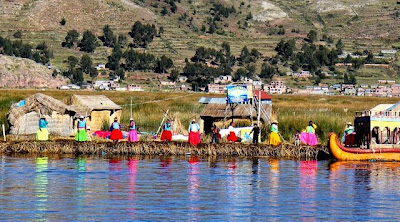Puno has a
population of approximately 150,000 and is located in the southeast portion of
Peru between the shores of Lake Titicaca and the mountains surrounding the
city.
There
is less than 2 miles of flat land between the shores and the foothills, which
has caused the growing city to continue to expand upwards onto the hillsides.
As a result, the town's less developed and poorest areas, which are high on the
hillsides, often have very steep streets, which are generally not paved and
cannot be accessed by automobile.
We
were greeted in our lobby at the Casona Plaza Hotel at 6:45am for our first
destination of the day – the Uros Islands of Lake Titicaca, the highest
commercially navigable lake in the world.
After arriving dockside, a brief introduction to our captain and guide,
we boarded our boat for the 45 minute trip.
I had pre-arranged for a private boat and private English speaking
guide. We did not want to join a group
of 40 – mainly due to our age, the extremely high altitudes and the strenuous
climb required to reach the restaurant where we would have lunch. We felt we
might hold back a larger group. This
added to the cost of our tour but we were glad we made this decision.
Fredy,
our assigned guide, was one of 11 siblings born on the Uros Islands and still lives
there today with his wife and 2 small children.
He proved to be a very knowledgeable and charismatic guide and we
thoroughly enjoyed our day with him. We
came to learn that infant mortality among the Uros people is high. Fredy related to us that 6 of his 11 siblings
died as infants by falling off the island into the frigid Lake Titicaca.
The Uros are a pre-Incan people who live on 78 floating islands in Lake Titicaca at an elevation of 12,500 feet. They are self-sufficient getting everything they need from their surroundings. The island construction is accomplished by using bundles of dried totora reeds, which grow in the lake. Not only are the reeds used to build each island, the families use reeds for construction of their homes, furniture and boats. The larger islands accommodate up to 10 families – normally all related – and the smaller islands between 3-4 families. The reeds at the bottom of the island rot away fairly quickly so new reeds are added to the top of the island every 14 days. This causes you to sink 2-4” with every step. The surface of the islands are uneven, thin and felt like you were walking on a water bed. Cooking is accomplished by placing clay pots on piles of stones. The ‘outhouse islands’ can be between 10-20 minutes away by boat so planning ahead is critical.
A
visitation to the Uros Islands, though primitive, is by a lottery selection process
and assures that each island and corresponding family receives equal opportunity
to provide tourist education and also affords them the opportunity to sell
their hand crafted items. We were
assigned to the island of Corazon Valiente.
Meeting the 3 families on this small island was a delight. We were educated on daily activities which including
building and maintenance of the island, food preparation and hunting
requirements.
The families then sang to
us in 4 different languages, one of which was English. We then had opportunity to go inside their
homes and purchase hand-crafted items, some of which take up to 3 months to
complete. Before leaving the Uros
Islands we opted to take a ride on one of the hand made reed boats. We also made a stop at, what Fredy called,
‘the modern island’. Here we enjoyed a
cup of coca tea, fresh baked bread and had our passport stamped showing we had
visited the Uros Islands. Then it was
back in the boat and off to Taquile Island.
















No comments:
Post a Comment